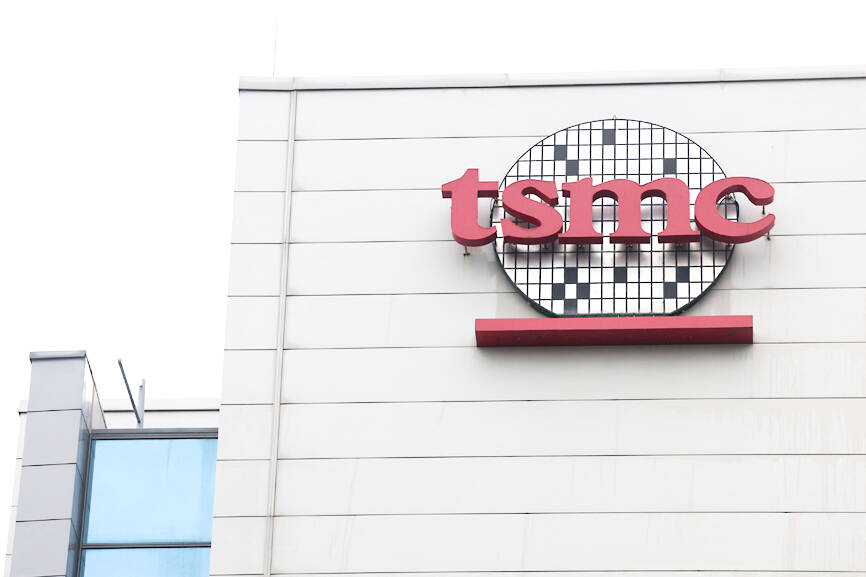Taiwan’s outbound investments hit a new high last year due to investments made by contract chipmaker Taiwan Semiconductor Manufacturing Co (TSMC, 台積電) and other major manufacturers to boost global expansion, the central bank said on Thursday.
The net increase in outbound investments last year reached a record US$21.05 billion, while the net increase in outbound investments by Taiwanese residents reached a record US$31.98 billion, central bank data showed.
Chen Fei-wen (陳斐紋), deputy director of the central bank’s Department of Economic Research, said the increase was largely due to TSMC’s efforts to expand production in the US and Japan.

Photo: AFP
Investments by Vanguard International Semiconductor Corp (世界先進), a smaller contract chipmaker, semiconductor distributor WT Microelectronics Co (文曄科技) and iPhone assembler Hon Hai Precision Industry Co (鴻海精密) were also factors, Chen said.
The central bank said the portfolio investment account posted a net asset increase of US$66.33 billion last year, down US$5.59 billion from a year earlier.
As a result, Taiwan’s net fund outflow, which measures the flow of direct and portfolio investments, reached US$94.39 billion in the year, an increase of US$9.02 billion from the previous year.
In the fourth quarter of last year, the country’s net fund outflow totaled US$30.70 billion, an increase of US$2.53 billion from the previous year, the 58th consecutive quarter of net fund outflows — the longest streak in Taiwan’s history.
As Taiwan continues to report net fund outflows in its financial account, concerns over sustained massive overflows have deepened.
About concerns that investors might continue moving funds out of the country, the central bank said that net financial account outflows are not unusual in a country such as Taiwan, which has a long-standing current account surplus.
The central bank said countries with long-standing current account surpluses, including Japan, Singapore, South Korea and Germany, have also tended to record net financial account outflows.
The current account primarily measures a country’s exports and imports of goods and services. Last year, Taiwan recorded a current account surplus of US$113.83 billion, an increase of US$7.99 billion from the previous year, the central bank said.
In the fourth quarter alone, Taiwan recorded a current account surplus of US$34.40 billion, down US$240 million from a year earlier, it said.
Chen said if Taiwanese companies generate profits from overseas direct investments, including dividend income, the gains would be logged as primary income in the current account.

CAUTIOUS RECOVERY: While the manufacturing sector returned to growth amid the US-China trade truce, firms remain wary as uncertainty clouds the outlook, the CIER said The local manufacturing sector returned to expansion last month, as the official purchasing managers’ index (PMI) rose 2.1 points to 51.0, driven by a temporary easing in US-China trade tensions, the Chung-Hua Institution for Economic Research (CIER, 中華經濟研究院) said yesterday. The PMI gauges the health of the manufacturing industry, with readings above 50 indicating expansion and those below 50 signaling contraction. “Firms are not as pessimistic as they were in April, but they remain far from optimistic,” CIER president Lien Hsien-ming (連賢明) said at a news conference. The full impact of US tariff decisions is unlikely to become clear until later this month

Popular vape brands such as Geek Bar might get more expensive in the US — if you can find them at all. Shipments of vapes from China to the US ground to a near halt last month from a year ago, official data showed, hit by US President Donald Trump’s tariffs and a crackdown on unauthorized e-cigarettes in the world’s biggest market for smoking alternatives. That includes Geek Bar, a brand of flavored vapes that is not authorized to sell in the US, but which had been widely available due to porous import controls. One retailer, who asked not to be named, because

CHIP DUTIES: TSMC said it voiced its concerns to Washington about tariffs, telling the US commerce department that it wants ‘fair treatment’ to protect its competitiveness Taiwan Semiconductor Manufacturing Co (TSMC, 台積電) yesterday reiterated robust business prospects for this year as strong artificial intelligence (AI) chip demand from Nvidia Corp and other customers would absorb the impacts of US tariffs. “The impact of tariffs would be indirect, as the custom tax is the importers’ responsibility, not the exporters,” TSMC chairman and chief executive officer C.C. Wei (魏哲家) said at the chipmaker’s annual shareholders’ meeting in Hsinchu City. TSMC’s business could be affected if people become reluctant to buy electronics due to inflated prices, Wei said. In addition, the chipmaker has voiced its concern to the US Department of Commerce

STILL LOADED: Last year’s richest person, Quanta Computer Inc chairman Barry Lam, dropped to second place despite an 8 percent increase in his wealth to US$12.6 billion Staff writer, with CNA Daniel Tsai (蔡明忠) and Richard Tsai (蔡明興), the brothers who run Fubon Group (富邦集團), topped the Forbes list of Taiwan’s 50 richest people this year, released on Wednesday in New York. The magazine said that a stronger New Taiwan dollar pushed the combined wealth of Taiwan’s 50 richest people up 13 percent, from US$174 billion to US$197 billion, with 36 of the people on the list seeing their wealth increase. That came as Taiwan’s economy grew 4.6 percent last year, its fastest pace in three years, driven by the strong performance of the semiconductor industry, the magazine said. The Tsai